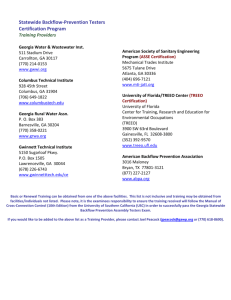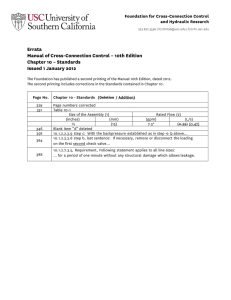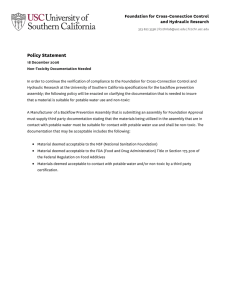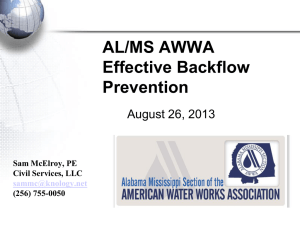Protection for Post Manual Review Mix Carbonators Committee Update
advertisement
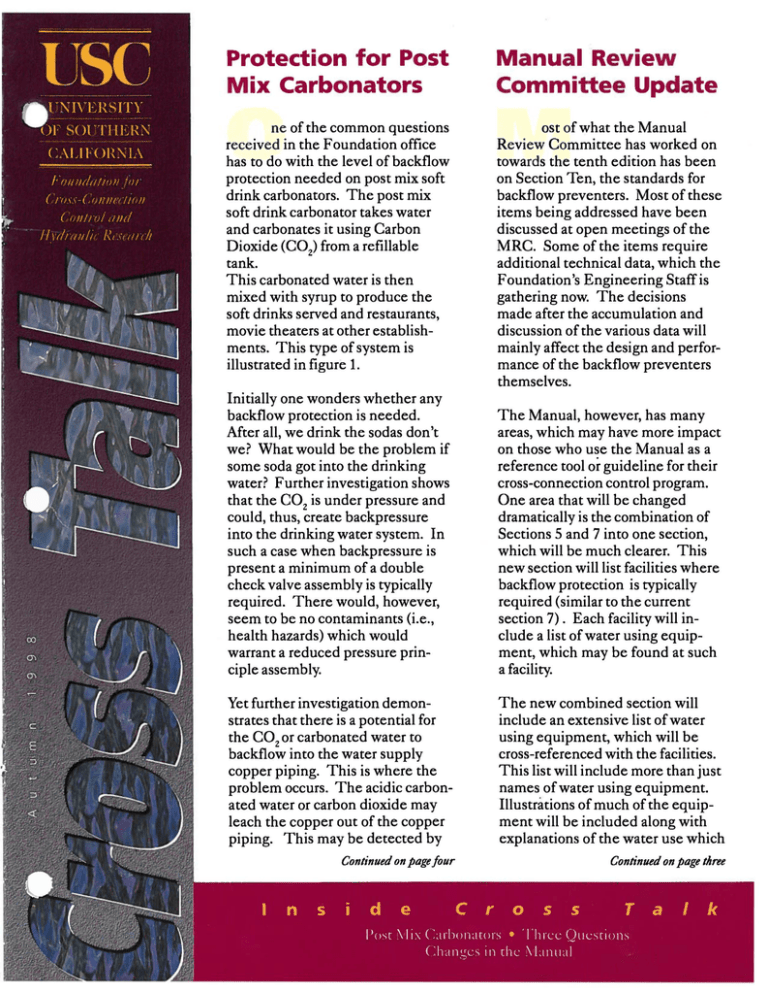
Protection for Post Mix Carbonators Manual Review Committee Update ne of the common questions received in the Foundation office has to do with the level of backflow protection needed on post mix soft drink carbonators. The post mix soft drink carbona tor takes water and carbonates it using Carbon Dioxide (C02) from a refillable tank. This carbonated water is then mixed with syrup to produce the soft drinks served and restaurants, movie theaters at other establishments. This type of system is illustrated in figure 1. ost of what the Manual Review Committee has worked on towards the tenth edition has been on Section Ten, the standards for backflow preventers. Most of these items being addressed have been discussed at open meetings of the MRC. Some of the items require additional technical data, which the Foundation's Engineering Staff is gathering now. The decisions made after the accumulation and discussion of the various data will mainly affect the design and performance of the backflow preventers themselves. Initially one wonders whether any backflow protection is needed. After all, we drink the sodas don't we? What would be the problem if some soda got into the drinking water? Further investigation shows that the C02 is under pressure and could, thus, create backpressure into the drinking water system. In such a case when backpressure is present a minimum of a double check valve assembly is typically required. There would, however, seem to be no contaminants (i.e., health hazards) which would warrant a reduced pressure principle assembly. The Manual, however, has many areas, which may have more impact on those who use the Manual as a reference tool or guideline for their cross-connection control program. One area that will be changed dramatically is the combination of Sections 5 and 7 into one section, which will be much clearer. This new section will list facilities where backflow protection is typically required (similar to the current section 7) . Each facility will include a list of water using equipment, which may be found at such a facility. Yet further investigation demonstrates that there is a potential for the C0 2 or carbonated water to backflow into the water supply copper piping. This is where the problem occurs. The acidic carbonated water or carbon dioxide may leach the copper out of the copper piping. This may be detected by The new combined section will include an extensive list of water using equipment, which will be cross-referenced with the facilities. This list will include more than just names of water using equipment. Illustriuions of much of the equipment will be included along with explanations of the water use which Continued on page four Continued on page tlzree Me1111bership he Foundation's Membership Program provides many benefits to the Members of the Foundation. These include: twenty percent discounts on Foundation Training courses for any employee of the Member company/ organization, the List ofApproved Backflow Prevention Assemblies, printed quarterly, and access to the up-to-the-minute version of the List for those Members with Internet access. r' Members are encouraged to call the Foundation with technical questions. The Foundation's Engineering Staff is available to assist Members with the various aspects of field testing backflow preventers, installing backflow preventers, administering their cross-connection control program. American Backflow Products Co. American Leak Detection Contading the Backflow Engineering Group Foundation City of Benicia City of Bloomington City of Blythe Water Dept. Mailing Address: Foundation for CrossCullins Plumbing Connection Control and & Fire Protection Hydraulic Research Dowl Engineers University of Flo-Rite Testing Southern California ( City of Kelowna 200 Kaprielian Hall Fluid Meter Service Corp. Los Angeles, CA 90089-2531 Gill Sewer & Darin Green River Community College Phone: Hydro 9 Irrigation District 213 740 2032 Kapalua Water Co. L. A. Gas and Water Works FAX: County of Lander 213 740 8399 Moapa Valley Water District North County Plumbing e-mail: Pala Environmental Protection fccchr@usc.edu Agency Web Site: Rural Community Assistance www.usc.edu/dept/fccchr Corporation City of Salem, VA The Foundation accepts San Francisco Water Dept. Purchase Orders via mail or Schmidt Fire Protection fax and credit card orders Siloam Water Association (Visa, MasterCard, Discover) State of Utah via telephone and the Web. UA Local 525 JATC Union Camp Cross Talk is published by the Foundation for Cross-Connection Control and Hydraulic Research at the University of Southern California for Foundation Members. Limited additional copies are available to Members upon request. (213) 740-2032 1997 ©University of Southern California. All riqhts reserved. l The Manual continuedfrom page one will help determine if the water use is a direct or indirect cross-connection and where the equipment would constitute a health hazard, or a non-health hazard. Ideally, the end user could take the Tenth Edition, look up the facility they are concerned with, and know what type of water using equipment one might expect to find there. Then they could look at the cross-reference to determine what type of cross-connection and what degree of hazard would be expected. With this information the type of backflow protection necessary is quite easily determined. (See Three Q uestions on page three.) T he problem with creating this section in this way, is that it is not actually possible to place all facilities into a group and always be accurate. Typically a certain type of facility may have specific equipment. However, every facility of that type may not. Also every piece of equipment isn't the same. Many facilities may have heat exchangers, for example, but some may be single walled heat exchangers and others double walled heat exchangers. Even though facilities and equipment will not always be exactly what we expect, this Section will be very helpful in preparing those who conduct site surveys. Going to specific facilities one can determine, in general, the equipment that may be found at such a facility. One can also gain some very specific insight about the various pieces of equipment, which may be encountered. Even if the equipment varies, at least the .ndividual conducting the site survey is much better prepared for the survey once they prepare using this new Section of the Manual. At this point in time the Committee is gathering information (i.e., pictures, illustrations, cross-sections, etc.) on all types of water using equipment and information about various types of facilities. Any information of this nature that you would like to contribute to the Committee, please send to The Manual Review Committee care of the Foundation Office. The MRC may be contacted through the Foundation office. Information on the committee meetings may be found on the web. The Committee is gathering information on all types of water using equipment. Any information of this nature may be contributed to the Committee, via the Foundation Office Manual Review Committee Foundation Office University of Southern California Kaprielian Hall200 Los Angeles, CA 90089-2531 213 740 2032 FAX: 213 740 8399 fccchr@usc.edu http://www.usc.edu/deptl fccchr/MRO -........ ,.rt Post Mix Carbonated Beverege Mixers continuedfrom page one To eliminate copper alloy in the water line to the carbonator, some jurisdictions have been requiring a stainless steel bodied RP as the backflow protection the discoloration of the water (i.e., blue water), or air (i.e., carbon dioxide) coming out of nearby faucets, or an "off-taste" in the soft drink being served. Ingesting large amounts of copper can cause acute gastrointestinal distress, vomiting and diarrhea. Should a person have food in their stomach, the proteins in the food may minimize the irrating effects of the copper. Because of this possibility of the leaching of the copper piping, there has been concern with any copper alloy being exposed to the carbonated water or C0 2• Therefore, we now have reason to need a reduced pressure principle assembly. However, to complicate matters, the bronze materials from which most RPs (i.e., 2" and smaller) are constructed fall into the "copper alloy" category. This raises another issue of concern. To eliminate copper alloy in the water line to the carbona tor, some jurisdictions have been requiring a stainless steel bodied RP as the backflow protection. However, it is the Foundation's position that an RP, bronze, plastic or stainless steel bodied, is acceptable with the following guidelines: 1. The carbonator pump does not exceed 175 psi, so that the RP is capable of handling the potential ~ (Of course the 0 Q) II CD c. ~ CD" ""'' backpressure would only occur if the non-vented double ball checks at the carbonator pump fail. For the RP to be contacted by the carbonated water or C02, the second check of the RP would also have to fail so that the C0 2 could travel back towards the RP.) 2. Piping from the RP to the carbona tor is not made of a copper alloy (i.e., copper tubing). Reinforced plastic or rubber, or stainless steel tubing is to be used. 3. RP is fieldtested in-situ at least annually. If these criteria are met there is no reason to require a stainless steel assembly. A bronze reduced pressure principle assembly should provide adequate backflow protedion and the potential of carbonated water coming in contad with the assembly is minimal. 4. RP is installed in compliance with local administrative authority requirements. If these criteria are met there is no reason to require a stainless steel assembly. A bronze reduced pressure principle assembly should provide adequate backflow protection and the potential of carbonated water coming in contact with the assembly is minimal. Notice about Cross Talk Members will note that the summer issue of Cross Talk was not published this year. The Foundation will, however, be publishing a special edition of Cross Talk before the next regularly scheduled edition, to be published this winter. The special edition of Cross Talk will specifically outline the elements needed for an effective cross-connection control program . Members wishing to see specific items discussed in future editions of Cross Talk are encouraged to forward suggestions to the Foundation Office. Three Questions Determining which backflow preventer to install in a specific situation may seem to be a difficult decision. However, this determination may actually be made by answering three questions. Determining which backflow preventer to install in a specific situation may seem to be a difficult decision. However, this · determination may actually be made by answering three questions. Question Number One: What type of crossconnection is it, indirect or direct? One needs to examine what type of crossconnection, if any, exists. Whether it be a cross connection at the system connection or a cross-connection at the point of use, one must decide if it is an indirect cross-connection or a direct cross-connection? An indirect cross-connection is a crossconnection which is subject to backsiphonage only. Backsiphonage is when the pressure upstream of the connection becomes sub-atmospheric, or drops to below atmospheric pressure. A direct cross-connection is a connection which is subject to backpressure. Backpressure is the condition that occurs when pressure downstream of the connection increases to a point above the pressure upstream of the connection, thus forcing the water to flow backwards through the connection. So for question number one; if there is a potential for backpressure, it's a direct connection. If backsiphonage only, then it's an indirect connection. Question Number Two: What is the degree of hazard? First we must define the degree of hazard. The Manual ofCross- Connection Control, Ninth Edition defines degree of hazard as follows: The term "degree of hazard" Shall mean either a pollutional (nonhealth) or contamination (health) hazard and is derived from the evaluation of conditions within a system So in other words, if a backflow condition occurs, what substance has the potential of getting into the water system? Is this substance considered a contaminant (i.e., a health hazard)? A health hazard is something that could cause illness or death if ingested. Or the substance could be a pollutant, (i.e., a non-health hazard) which is only aesthetically objectionable. This is something that may look bad, smell funny, or taste unusual, but will not cause illness or death if ingested. In some cases one may not know whether a substance is a pollutant or contaminant. In this case the administrative authority should contact the proper health authorities in order to determine whether the substance is a heath hazard or non-health hazard. Material Safety Data Sheets (i.e., MSDS) would also be an excellent source of information. Question Number Three: Is the system under continuous use (or pressure)? Continuous use needs to be clearly defined. A connection under continuous use or flow would be a connection which would be under pressure for more than twelve of any twenty-four hours and no shutoff valves or obstructions downstream. Once all three of the above questions have been answered the determination ofwhich type of backflow protection to install at the connection is easier. First a basic understanding of the use of the various backflow preventers is necessary. Pressure Vacuum Breaker Assembly (PVB) or Spill Resistant Pressure Vacuum Breaker (SVB) The pressure vacuum breaker assembly may be used to protect against an indirect cross-connection only with pollutants or contaminants present. The assembly may be used under continuous pressure. Atmospheric Vacuum Breaker (AVB) Double Check Valve Assembly The atmospheric vacuum breaker (DC) may be used to protect against an and DCDA indirect cross-connection The double check .----------------, only with pollutants or valve assembly may Is the system contaminants present. be used to protect under backpressure? The assembly shall be against direct or used under nonindirect cross-concontinuous nections with pollutpressure. ants present. It shall not be used to Contaminant? Contaminant? protect against a contaminant. The assembly may be used under continuous use. With the information here the flowchart shown on this page may be use to determine which backflow preventer should be used in any particular application l 1 RP Reduced Pressure Air Gap Principle Assembly (RP) and RPDA The reduced pressure principle assembly may be used to protect against a direct or indirect crossconnection with pollutants or contaminants present. The assembly may be used under continuous use. Under continuous pressure? DC RP Air Gap PVB With the RP informaAir Gap AVB tion here PVB the flowchart shown on RP this page may be use Air Gap to determine which backflow preventer should be used in any particular application. This is a quick guideline in helping one to determine which type of backflow preventer is acceptable for which type of water use, and hydraulic condition. Under continuous pressure? PVB DC RP AVB AirGap PVB RP DC Air Gap l r Training Courses Tester Course Los Angeles, CA 25-29 January 1999 Los Angeles, CA 10-14 May 1999 Escondido, CA 7-11 June 1999 Los Angeles, CA 12-16July 1999 Specialist Course Los Angeles, CA 1-5 February 1999 Incline Village,NV 15-19March 1999 Los Angeles, CA 19-23 July 1999 Upcoming Events Testing and Troubleshooting Update Southern California ABPA •Santa Margarita, CA 20 January 1999 Repair Session Southern California ABPA •Santa Maria, CA 17 February 1999 Ninth Annual TREEO Conference •Gainesville, FL 25-26 February 1999 Michigan Backflow Prevention Association Conference •Southgate, MI 8-9 March 1999 AWWA Teleconference •Various download cities throughout the nation 11 March 1999 Utah ABPA Conference •Salt Lake City, UT 19 March 1999 Testing and Troubleshooting Update Southern California ABPA • Foundation Laboratory, Los Angeles, CA 24 March 1999 usc UNIVERSITY OF SOUTHER.!.~ CALIFORNIA Foundation for Cross-Connection Control and Hydraulic Research School of Engineering Univers1ty of Southern Californ1a Kaprielian Hall 200 Los Angeles, California 90089-253 1 First Class US Postage PAID University of Southern California
